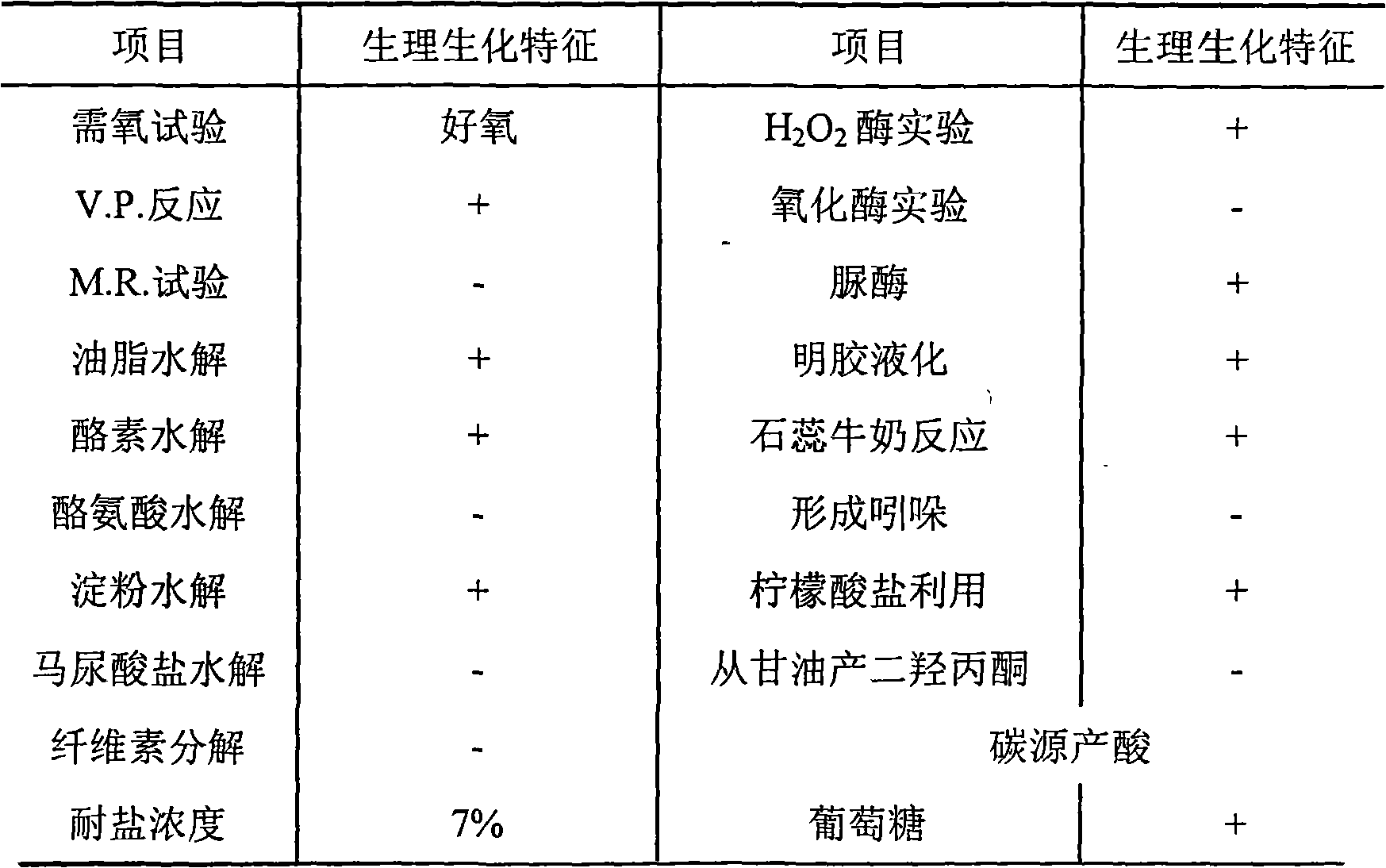Bacillus subtilis and application thereof in biological deodorant
A technology of Bacillus subtilis and biological deodorant, which can be applied to Bacillus subtilis and its application field in biological deodorant, and can solve the problems of weak degradation ability of organic matter and the like
- Summary
- Abstract
- Description
- Claims
- Application Information
AI Technical Summary
Problems solved by technology
Method used
Image
Examples
Embodiment 1
[0043] In a sterile ultra-clean workbench, use an inoculation loop to scrape 3 rings of the slant strain of Bacillus subtilis HF-A1 (CGMCC No.3230), and inoculate it into the first-level liquid seed medium (glucose: 15, yeast extract: 10, Peptone: 10, CaCl 2 : 3, KH 2 PO 4 : 5, Na 2 HPO 4 12H 2 O: 4, MgSO 4 ·7H 2 O: 6, pH7.0, unit: g / L, 115°C, sterilized for 20min). Shake culture at a temperature of 30° C. and a rotational speed of 150 rpm for 48 hours to obtain a grade 1 seed liquid. The primary seed liquid is transferred to a sterilized medium containing the same components according to the inoculum amount of 10% and cultivated under the same conditions, and the secondary seed liquid can be obtained after 48 hours.
[0044] Inoculate the secondary seed liquid into 35L sterilized liquid medium according to the inoculation amount of 10% (the volume of the fermenter is 50L), glucose: 30, beef extract: 10, peptone: 8, CaCl 2 : 5, KH 2 PO 4 : 8, Na 2 HPO 4 12H 2 O: ...
Embodiment 2
[0045] Example 2 Indoor Garbage Deodorization Test
[0046] In a sealed room, put a pile of highly rotten garbage that produces stench, and this biological deodorant (the fragrance-free biological deodorant prepared according to the method of Example 1) is diluted 10 times with tap water before use , Spray 200ml with a spray gun, and try to make the spraying range of deodorant spread over the garbage dump area. Set up different collection sites around the garbage for sampling, and measure the H in the malodorous gas before spraying and 15 minutes after spraying 2 S and NH 3 Concentration, the sampling point is 1m away from the edge of the odor source, the sampling height is 1.3m, 5 points are sampled, and the average value is taken. Odor concentration adopts three-point comparative smelly bag method (GB / T14675); ammonia adopts sodium hypochlorite-salicylic acid spectrophotometry (GB / T14679); hydrogen sulfide adopts polyvinyl alcohol ammonium phosphate absorption-methylene bl...
Embodiment 3
[0050] Embodiment 3 deodorizing effect and cost comparison
[0051] Divide a pile of garbage into four equal parts, place them in four rooms with the same area and space volume, and spray four kinds of deodorants respectively. According to the method of Example 2, the difference in the deodorizing effect of different brands of deodorants with the same volume and the same dilution was investigated, and the results are shown in Table 3. Wherein, the biological deodorant of the present invention is a fragrance-free biological deodorant prepared according to the method of Example 1.
[0052] Table 3. Comparison of deodorization and cost between this biological deodorant and common products in the market
[0053]
[0054]
[0055] As can be seen from Table 3: the biological deodorant provided by the present invention is obviously superior to other deodorants in cost and deodorizing effect. Embodiment 4 to the deodorization of domestic sewage
PUM
 Login to View More
Login to View More Abstract
Description
Claims
Application Information
 Login to View More
Login to View More - R&D
- Intellectual Property
- Life Sciences
- Materials
- Tech Scout
- Unparalleled Data Quality
- Higher Quality Content
- 60% Fewer Hallucinations
Browse by: Latest US Patents, China's latest patents, Technical Efficacy Thesaurus, Application Domain, Technology Topic, Popular Technical Reports.
© 2025 PatSnap. All rights reserved.Legal|Privacy policy|Modern Slavery Act Transparency Statement|Sitemap|About US| Contact US: help@patsnap.com



